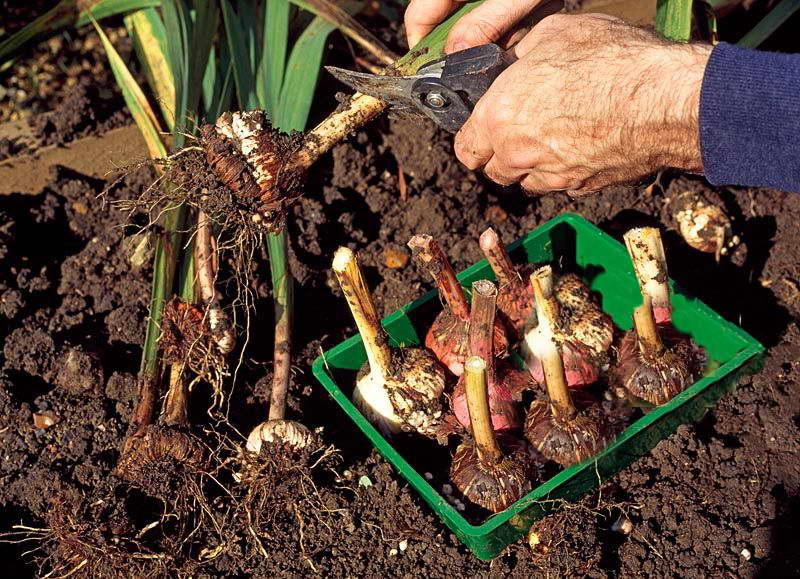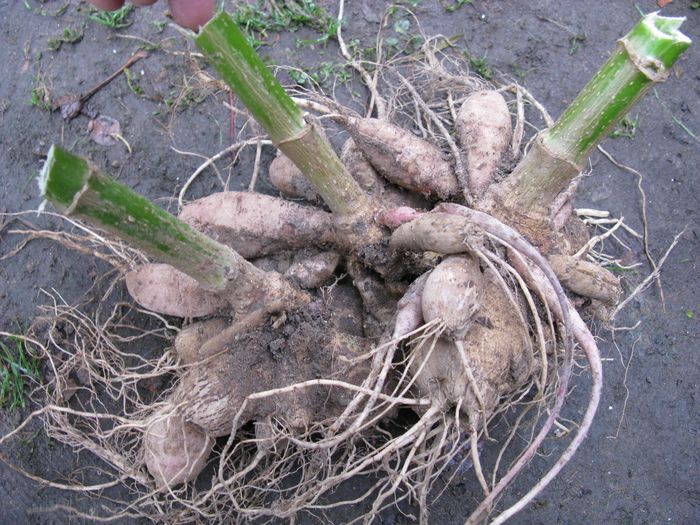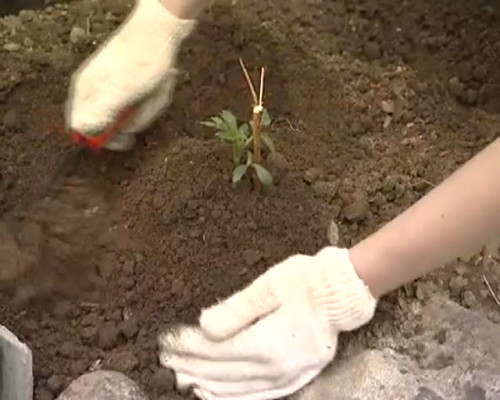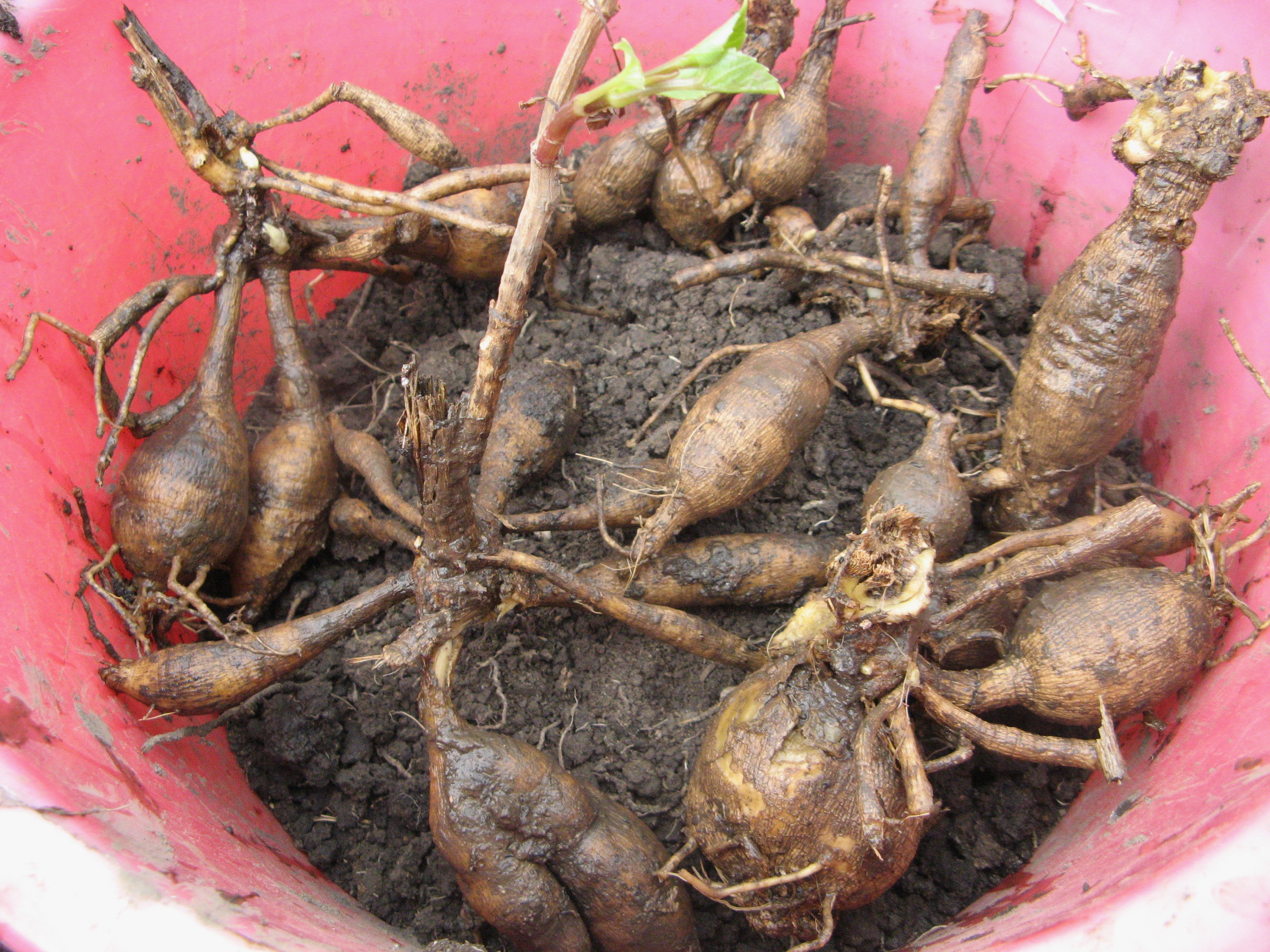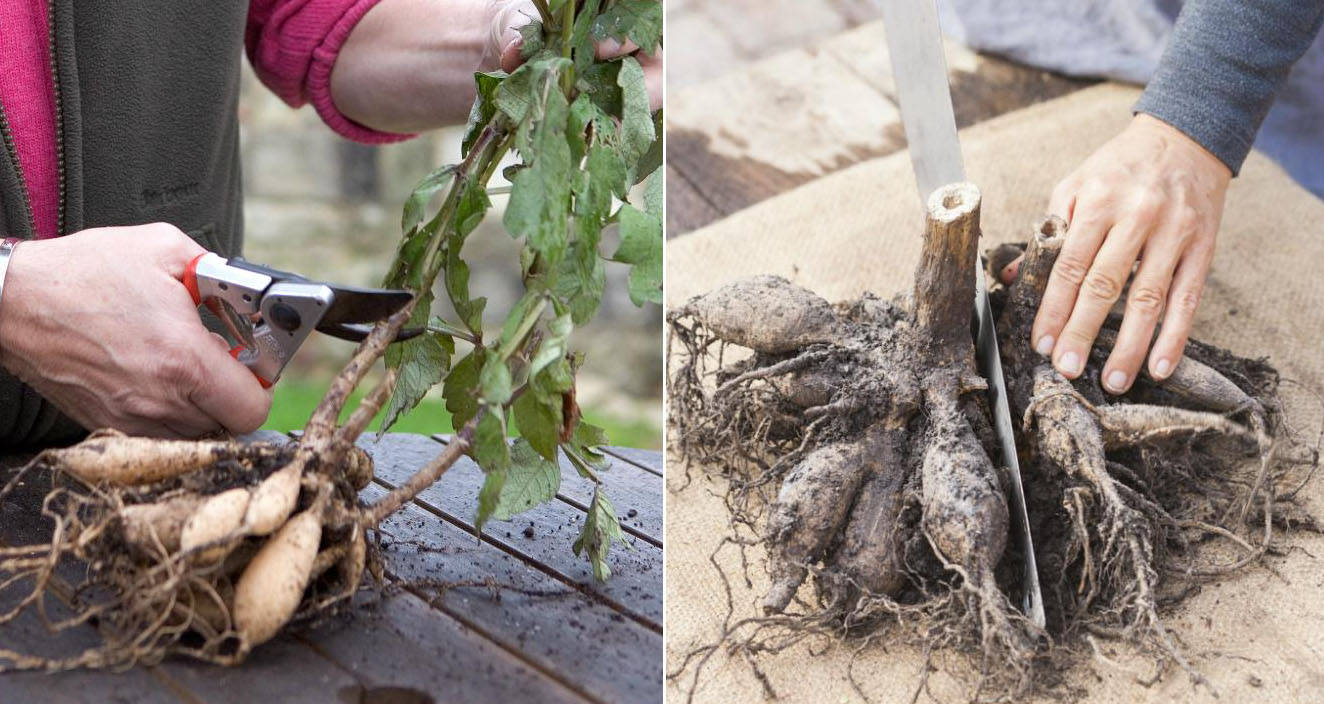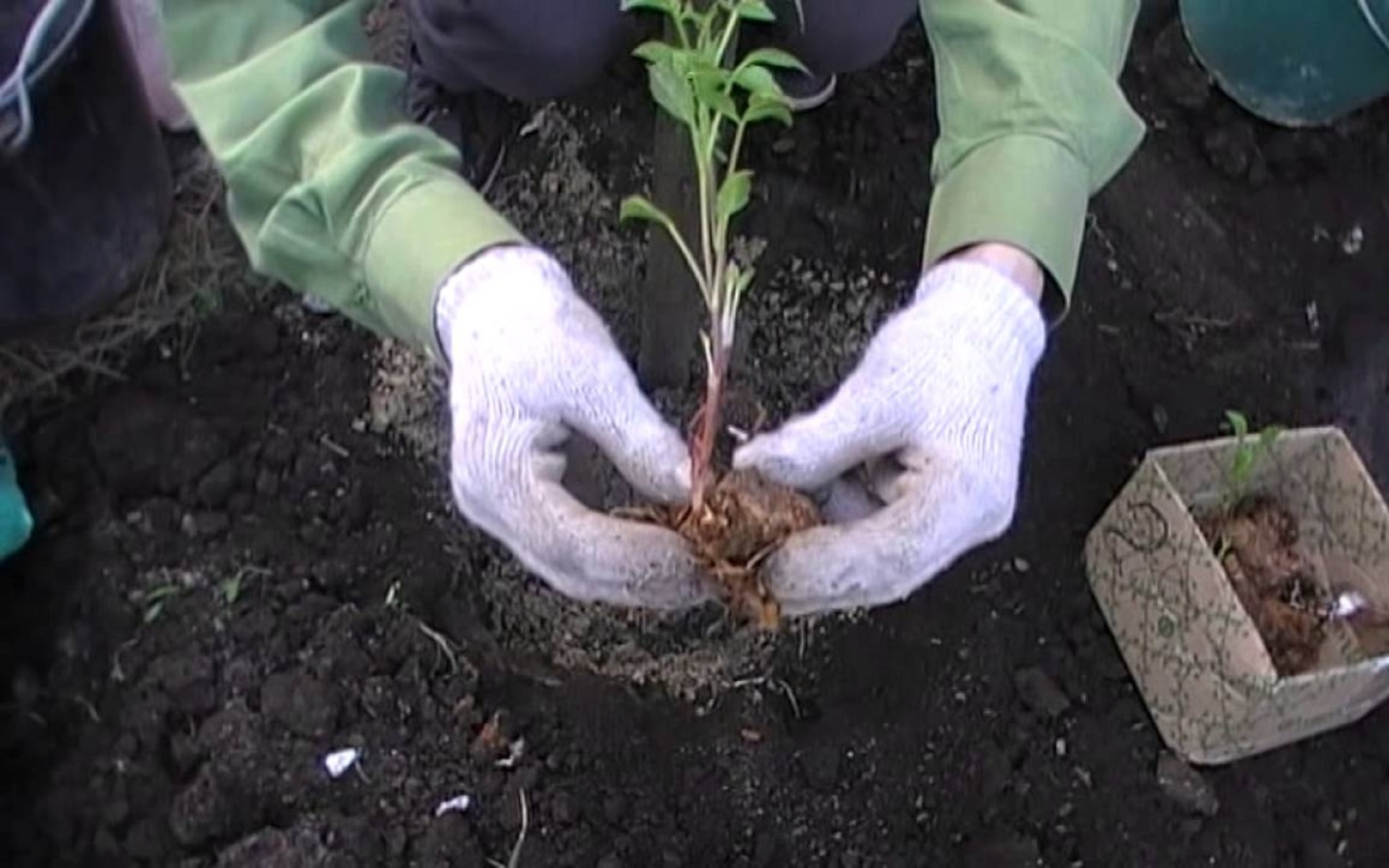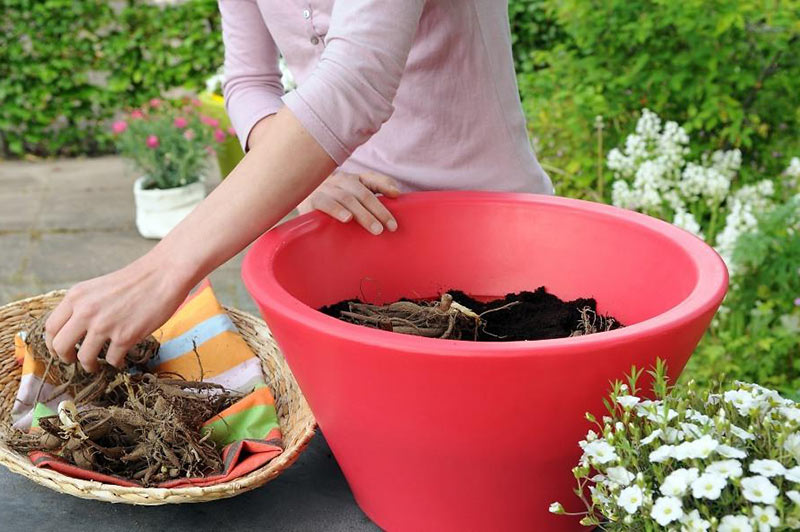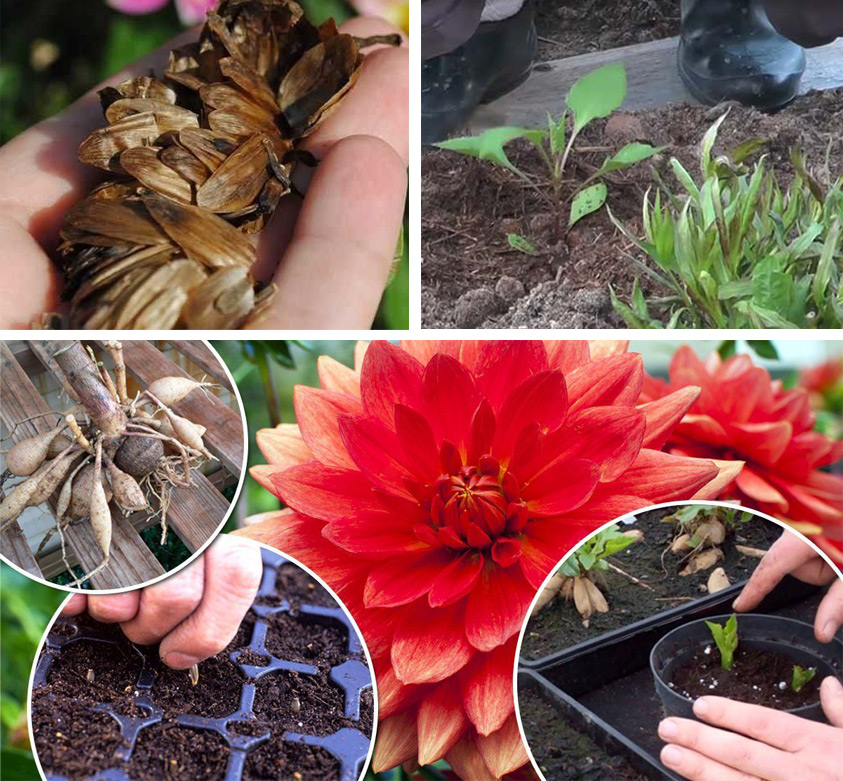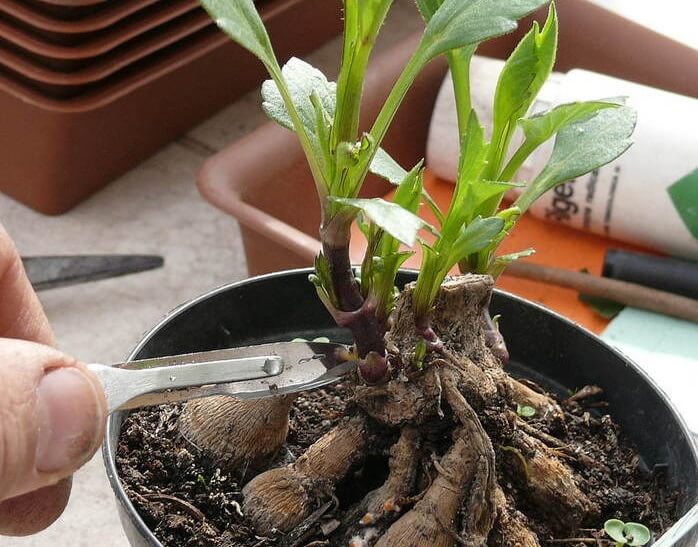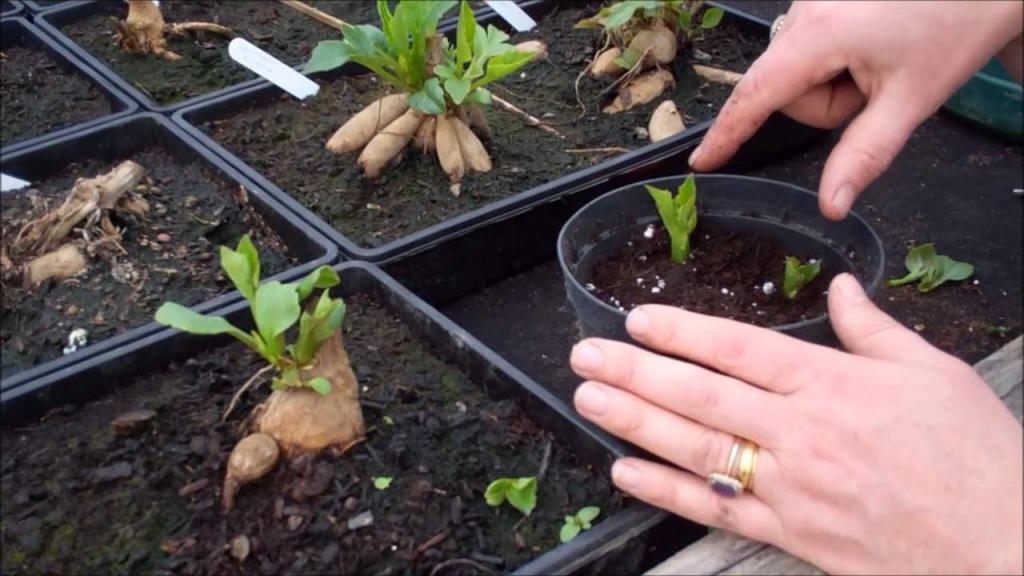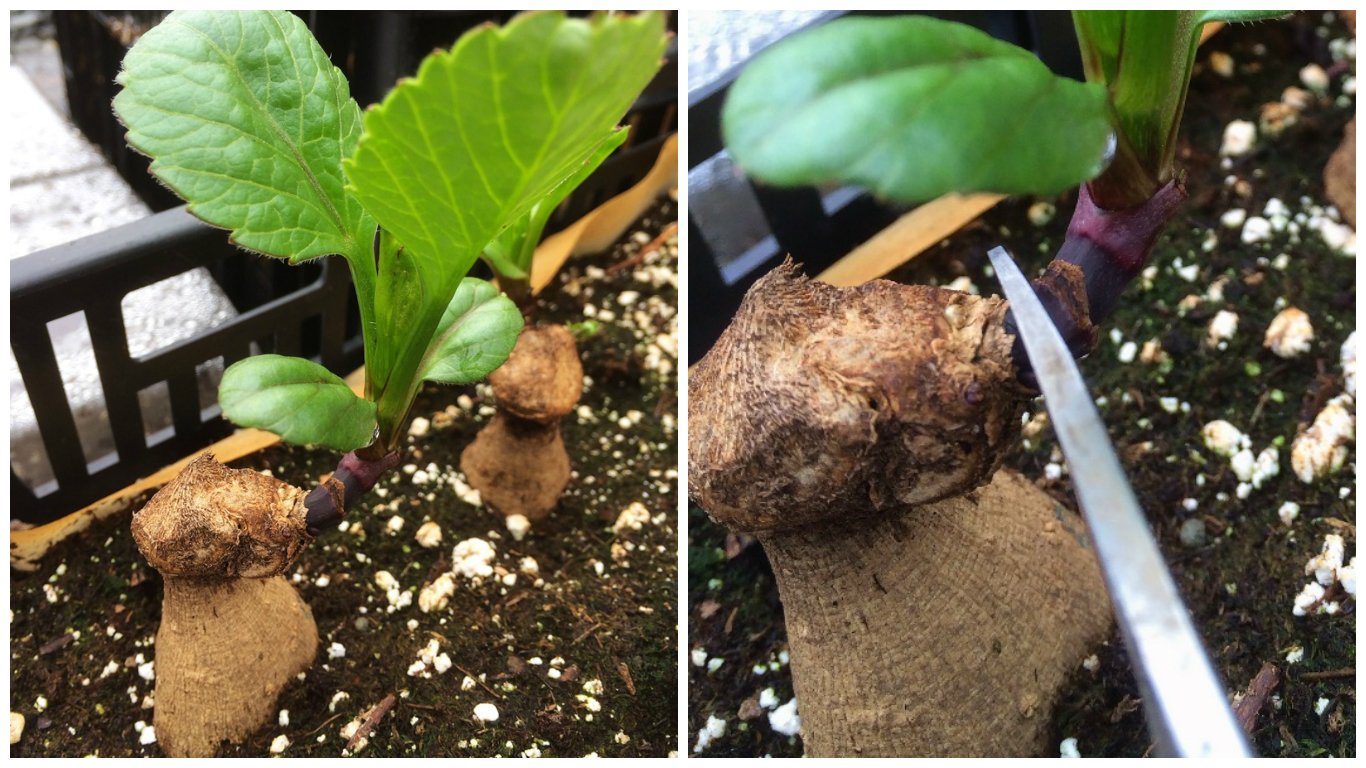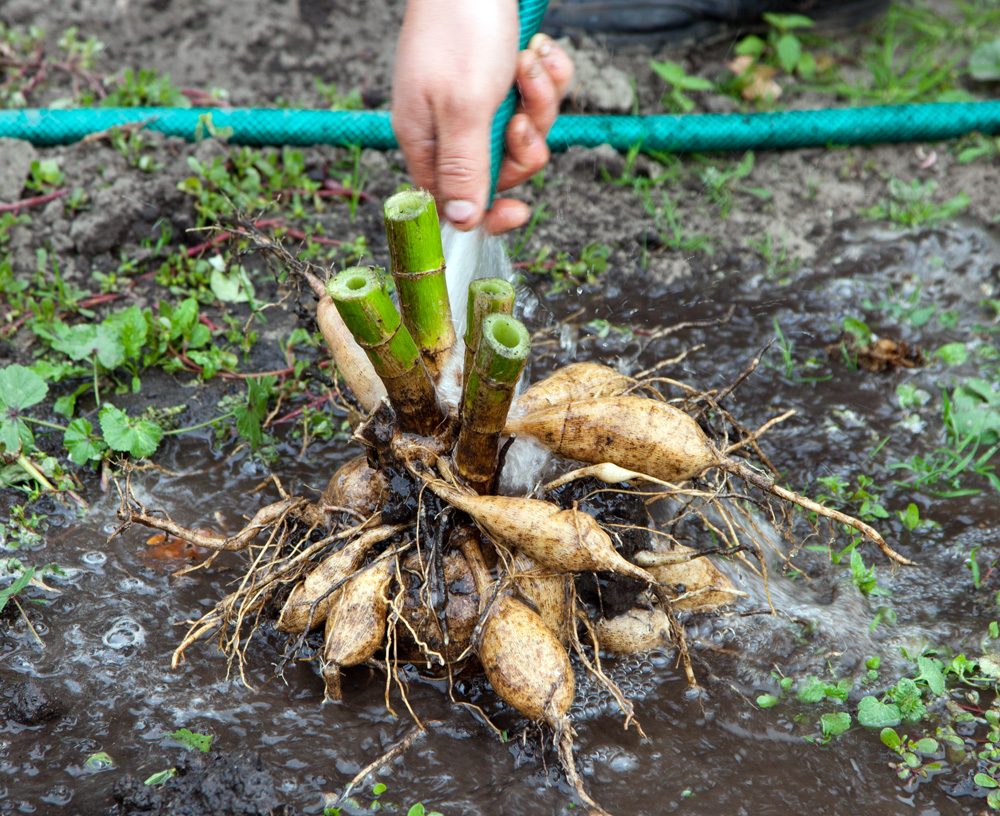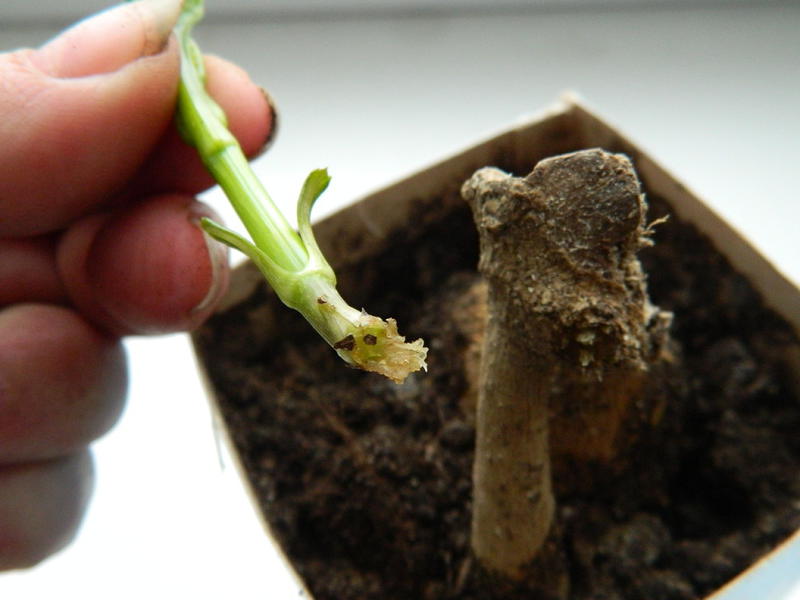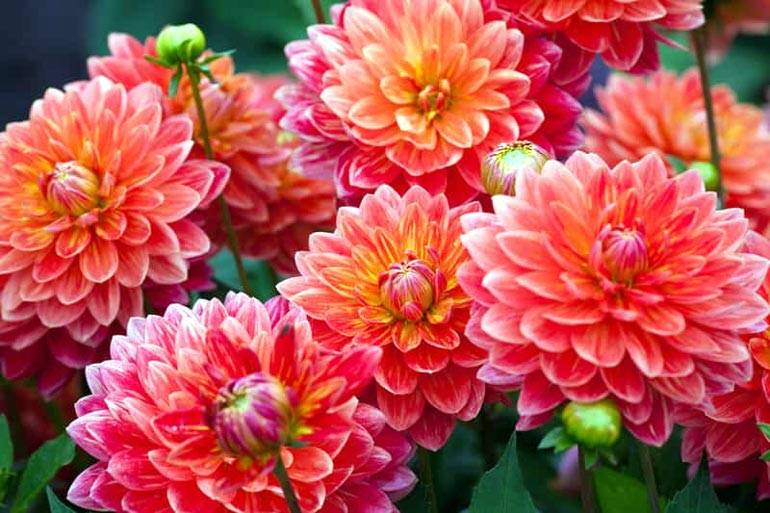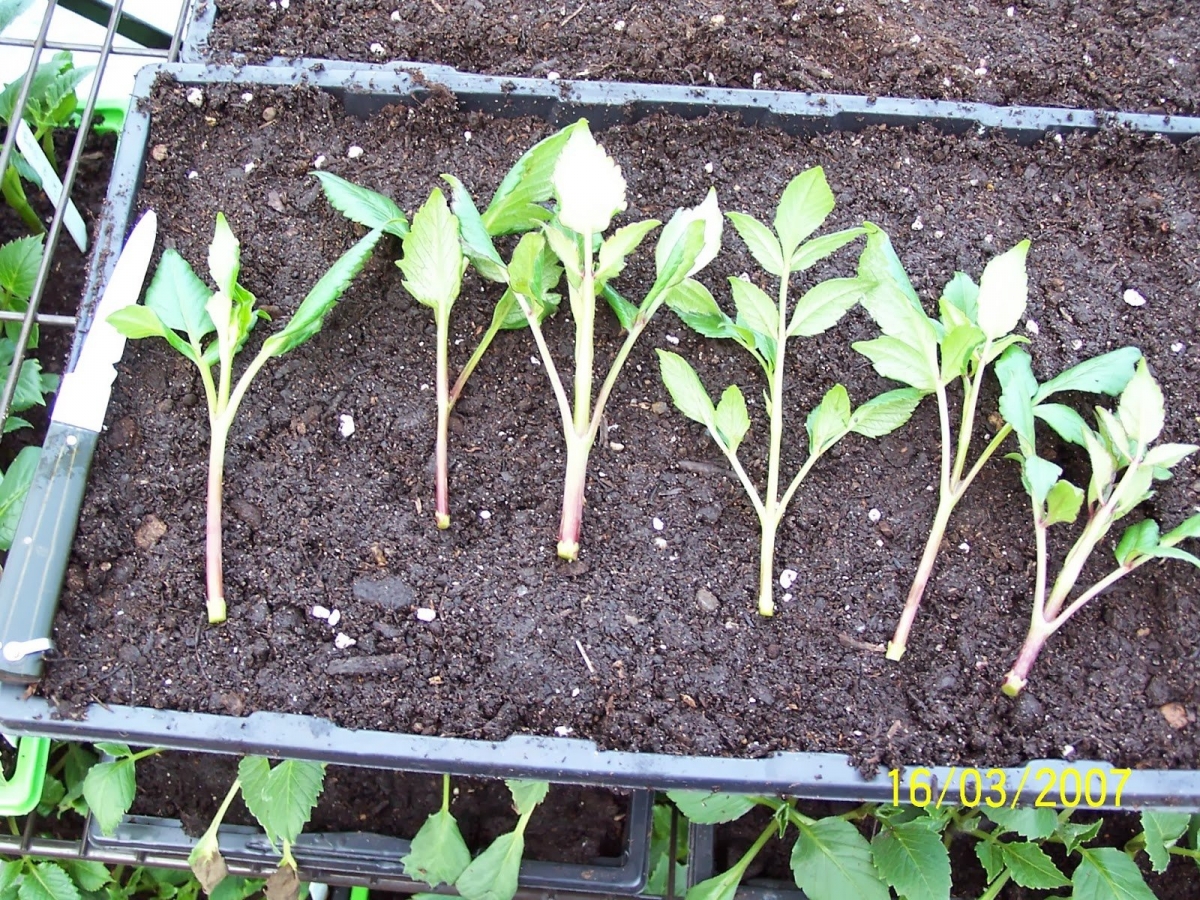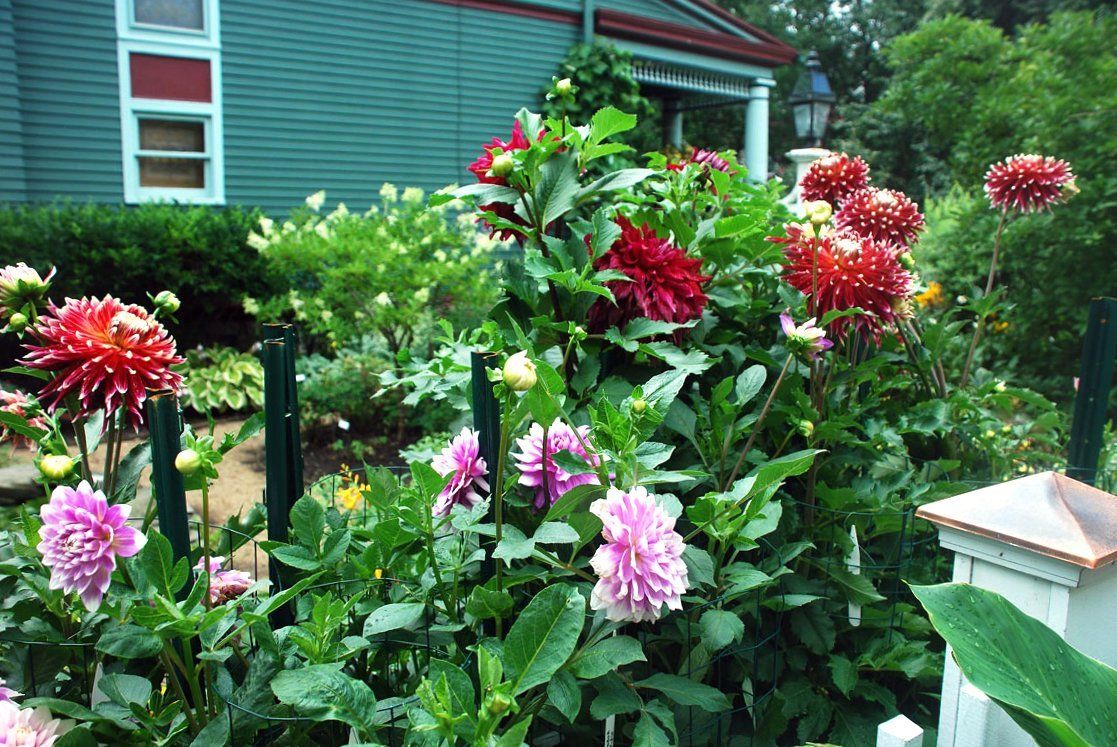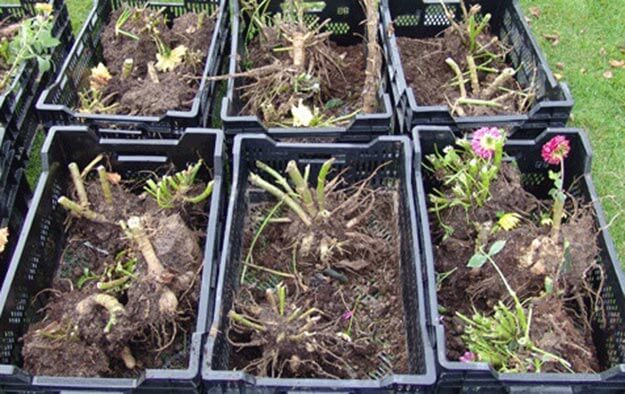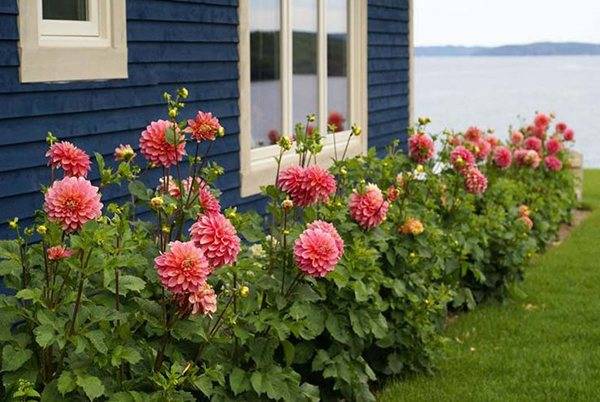How to grow dahlias in the country: soil preparation
Preparing the soil for dahlias is carried out in advance. During autumn digging, compost and humus are introduced into it at the rate of 3-5 kg per 1 m3. In spring, mature compost with the addition of wood ash is scattered over the entire area and the soil is loosened with a rake. If you did not have time to do this preparation, fertilizer can be applied to the planting holes before planting.


Dahlias are demanding on the soil. It must be fertile, permeable, with a good loose structure, well-drained, so that water does not stagnate in it. Stagnant water can lead to decay of roots and tubers. In this case, you will not be able to save the dahlias for planting next year.
The reaction of the soil should be neutral or slightly acidic. Too acidified soil is corrected by liming - the introduction of slaked lime. If the soil has an alkaline reaction, it must be acidified - add a small amount of peat.
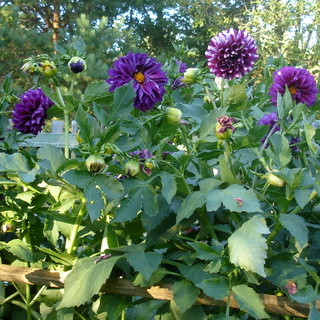

In the process of growing dahlias in the country, keep in mind that these plants greatly deplete the land, since the formation of tubers requires a lot of nutrients and moisture. Therefore, it is undesirable to plant them for two years in a row in the same place. You should also not alternate over the years on the same site with dahlias with asters. These plants are very close, prone to the same diseases. Their alternation will lead to the accumulation of the pathogens of these diseases in the soil.
If the soil has low permeability, it can be corrected by adding coarse river sand, gravel, fine sieved coal slag and other materials that increase permeability. To improve the structure of the soil and increase its fertility, any organic matter is added to it.
Dahlia breeding
There are two ways to breed dahlias: by dividing the tuber and by cuttings.
When dividing a tuber, you need to clearly see the growth points. Because each half of the tuber must receive a part of the root collar with sprouts or "eyes". Because the dahlia rhizome has features, and not any part of it can give sprouts, but only the stem.
It is convenient to divide the tuber when there are already well-regrown stems. For example, before planting seedlings in the ground.

We divide the dahlia so that each part of the tuber carries a new stem. Thus, we get several independent plants that will easily take root and grow.

Reproduction by cuttings is also carried out in sprouted tubers. The root is dug out, and a new sprout is cut off from it with a sharp knife, with the capture of a part of the tuber.
This is called heel grafting.

We plant the cutting in a separate pot, water it. Quickly enough, he will start up new roots, and then form tubers.

The root from which we cut the sprout should be returned to the ground, and it will also release new shoots.
You can also make stem cuttings of dahlia. When the seedling has three pairs of true leaves, the stem can be cut just above the first pair.
In this case, the cutting should be planted in the ground under the bottle until roots form.
In the future, the rooted cuttings are planted in the garden by transshipment.
Dahlia soil preparation
Before you start planting the flowers in question, you need to know that they love fertile soil, which should be loose and provide plants with sufficient nutrients. This suggests that the preparation of the soil should be dealt with in the fall. To do this, it should be dug up and organic fertilizers, and more specifically manure, should be applied. You can learn more about organic fertilizers for your site in this article... For 1 sq. m. plot requires about 5 kg of manure. Also, it will not be superfluous to add bird droppings per 1 sq.m., 100 g and a glass will be enough wood ash... Front planting dahlias in open ground in the spring, manure should be added to the prepared pits, which is mixed with humus. In the event that you did not prepare the soil in the fall, then in the spring 1 kg manure is introduced into each hole, alternating with the ground.
Propagation of dahlias by grafting
Vaccination is a rather troublesome process, and therefore not very popular among flower growers. Nevertheless, dahlia bushes obtained in this way bloom earlier and by autumn they grow larger tubers than cuttings.
For grafting, take healthy tubers remaining after dividing, unsuitable for planting, and a cutting of the desired variety. Wash the tuber thoroughly, dry it and cut a tapered hole in it. Sharpen the lower part of the cutting with a knife, also cone-shaped, and insert into the hole of the tuber.
Wrap the grafting site tightly with a cotton or woolen rope and plant the tuber with a shank in the soil. The beneficial substances contained in the tuber will provide the stalk with strength, and pretty soon you will get a lush bush.
An adult plant can also be vaccinated:
- with a clean sharp knife, cut the stem of the stock (mother bush) at the desired height and split it;
- on the scion (cuttings of the desired variety), make a small wedge-shaped cut;
- insert the stalk into the split so that its cambium (a thin strip of tissue under the bark) joins the cambium of the rootstock;
- wrap the vaccination site tightly with a long cotton tourniquet;
- Dip the end of the tourniquet into water - this will help maintain the desired level of humidity.
After 7-10 days, carefully inspect the scion, but do not unwind the harness so as not to harm the plant. By this time, the stalk should have taken root. If this does not happen, the graft will dry out or rot.
The tourniquet is recommended to be removed no earlier than after 1-1.5 months. In the next season, you will be able to see the result of such a vaccination, but there is a risk that the color of the resulting dahlia will not be as bright as on the mother bush.
Dahlia varieties with photos and names
The dahlia family has countless varieties.
And also according to the shape of flowers, dahlias are:
- single row
- anemic
- cactus
- semi-cactus
- spherical
- nymph
- pompom
- collar
- decorative
- mixed
Also called simple. As a rule, these are undersized non-double varieties with petals in one row.
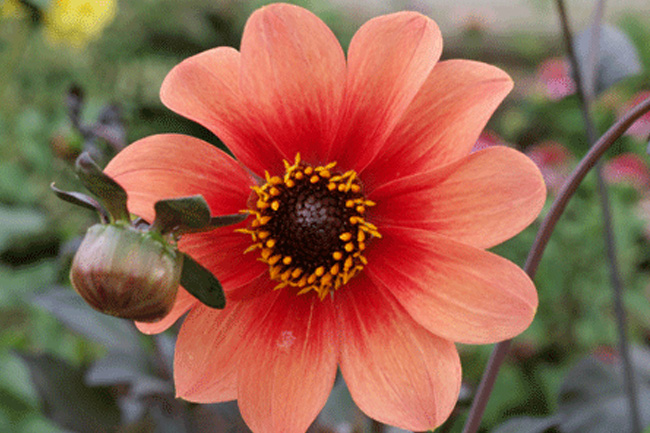
Happy kiss variety
Stunted, with semi-double buds.
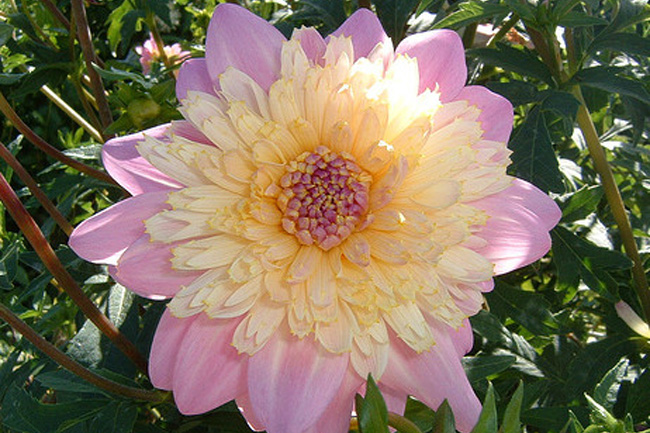
Lambada variety
Cactus dahlias
They have numerous petals twisted into tubes that resemble cactus needles. May have different heights and color variations.
As a rule, they have large flowers, up to 25 cm in size.

Shooting star cultivar
Semi-cactus dahlias
They have large double flowers (up to 25 cm in diameter) with incompletely twisted petals. They have a height of 80 cm to 150 cm.

Mick's Peppermint variety
Spherical dahlias
Annuals, as a rule, are short, with a long flowering and a flower diameter of about 15 cm. Their flowers are spherical in shape with rounded petals twisted into tubes.

Marble Ball grade
Nymphae dahlias
Medium-sized double flowers, in shape really somewhat reminiscent of a nymphea. Therefore, they are often called lotus. They have large flowers up to 20 cm in diameter.
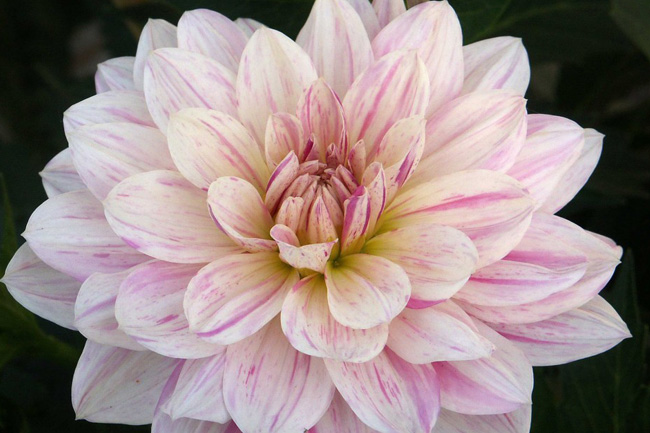
Bonesta variety
Pompom dahlias
A medium-sized species of dahlias, with unusual spherical double inflorescences (up to 10 cm in diameter) that resemble pompons. Has a wide variety of colors, unpretentious.
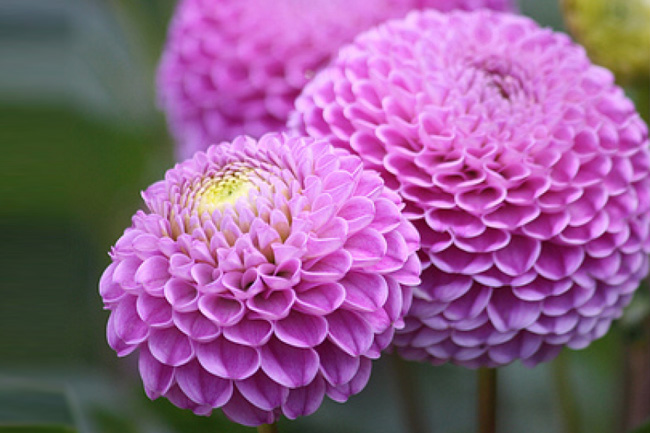
Franz Kafka variety
Collared dahlias
In addition to the main row of petals, they have a peculiar, different color, "collar", which gives them an elegant look. Medium-sized, flower diameter up to 10 cm.
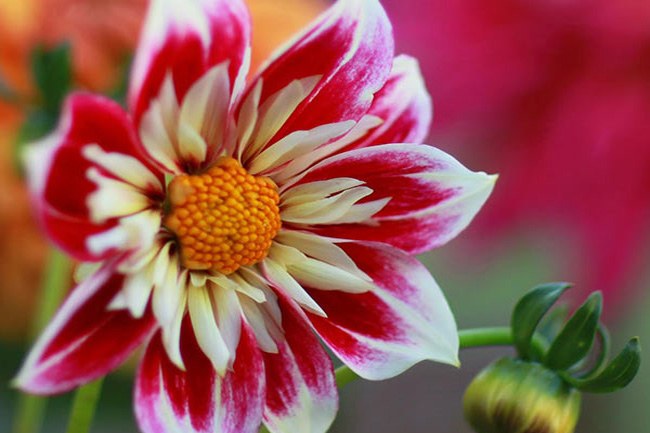
Fashion Monger variety
Decorative dahlias
These include many varieties with different colors and double shapes, with very large flowers up to 30 cm.

Tartan variety
Mixed dahlias
They are diverse, they can combine signs of different types. Medium-sized, large-colored, with various color options.

Gallery Art Deco variety
Dahlia varieties with video titles
To get acquainted with the magnificence of the species and names of dahlias, we suggest watching this video.
There is where to roam, everyone will find a dahlia to their taste and color. We showed you only a small part, because the number of varieties of dahlias has already exceeded several thousand!
Advantages and disadvantages of propagation by cuttings
The most common and easiest way to get new plant specimens is by dividing the tuber. But many gardeners prefer cuttings, since this method has a number of advantages over tuberous:
Dahlias obtained by cuttings bloom faster than propagated in other ways, as they germinate and take root in March.
It is enough to purchase one tuber to get several dozen flowering bushes in the same season.
When sprouting tubers at home, you can identify diseased plants and remove them before planting in the garden.
The sprouts are planted already strong and better resist pests.
A tuber planted in the soil in spring can rot from excess moisture and destroy the entire plant. The root system of the cuttings without tubers is less likely to rot. 95-97% of all young specimens survive.
Some types of dahlias grow new tubers very slowly, which leads to aging and degeneration of the variety. In this case, the only way to preserve the traits is by cuttings.
Cuttings produce plants with larger and healthier flowers and stems.
The method is not ideal, except that it takes a long time, it has other disadvantages. By the end of the season, only small tubers have time to grow and in small quantities, but they are quite suitable for storage and planting for the next year. A young stalk damaged mechanically or by pests is likely to die, while new shoots from dormant buds would grow on the tuber. When rooting in small pots, the root system of the cuttings is intertwined, which can cause curved tubers to form. To breed a dahlia in this way, you will need a large space, many containers and equipment.
Even taking these shortcomings into account, most professional florists recognize cuttings as the best way to get beautiful flowers with pronounced varietal characteristics in the same year. For example, cuttings according to the method of Marina Chernoivanova, a famous flower grower, provides early, abundant flowering and the ability to cut buds to create bouquets.
Breeding methods for annual and perennial dahlias
This plant is propagated in three ways:
- division of rhizomes;
- cuttings;
- seeds.
Division of rhizomes
You should start dividing tubers in March or April, depending on the region. We take out the planting material from the storage, inspect it, remove the dried and rotted areas of the tubers, disinfect the sections. We place it in small containers with moist peat or sawdust in a warm place at a temperature of at least 18 degrees in order to wake up the eyes and clearly see how the rhizomes can be divided into divisions. We carry out the division with a sharp knife, having previously disinfected it. We try to make each layer with 1-2 buds and two nodules. We dry the cuts with ash or crushed coal and again place them in sawdust or soil for further germination.
Cuttings
Cuttings are carried out for the rapid reproduction of especially interesting dahlias. In the spring, garden centers display many different varieties of these wonderful flowers. Choose the most beautiful one.At home, inspect the roots again, soak for 2 hours in a solution of epin or zircon (dilute according to the instructions). Then plant the plant in a flat, low container (disposable deep bowls are suitable) so that the backs of the tubers are on the surface. Place in a warm, bright place.
After a few days, sprouts will appear from the dormant buds. When they reach a size of 5-7 cm, gently break them off at the base and stick them into the prepared soil to a depth of 2-3 cm.In order not to damage the tissues at the lower end of the cutting, make a depression in the soil with a stick or pencil
Press down gently around the stem, water and cover with a plastic bag for optimal moisture
Further, make sure that the ground is constantly wet, but there is no swamp, and open the bag for airing once a day. Thus, a lot of planting material can be obtained throughout April. And on the mother plant, leave three shoots and then, like the rooted cuttings, plant them in open ground in late May - early April.
Propagation by seeds of annual varieties
For those who do not have the opportunity to store tubers in the winter, or who do not like to tinker with planting material, there is the possibility of growing dahlias from seeds. In the southern regions of our country, all annual dahlias can be planted directly in open ground in late April or early May. But for earlier flowering, as well as in central Russia, it is advisable to grow them through seedlings.
To do this, sow dahlia seeds in March in low containers, lightly sprinkle with soil, and moisten. Cover the bowls with a plastic bag and put them in a bright, warm place. Crops should be periodically ventilated and monitored so that the soil does not dry out. After 10-12 days. when shoots appear, the shelter can be removed only not immediately, but first by opening it slightly.
After the appearance of two real leaves, it is necessary to make a pick - to plant the seedlings in separate cups. To land on a permanent place in late May - early June, when the threat of frost has passed.
Dahlia breeding methods
Dahlias can be propagated in the following ways:
Dividing tubers
The most reliable and fastest way to reproduce a flower is by dividing the tubers. Young shoots newly formed during the previous season are separated in the spring. It is necessary to divide the tubers in such a way that each one has three to four points of growth and a part of the mother's stem must remain.
The division is carried out using garden shears or a sharp knife. The place of scrapping is sprinkled with ash for disinfection.
IMPORTANT. Division is a mandatory process
It is impossible to plant the entire nest in one hole, because the bush will thicken, and the shoots will be weak, and the flowers will become smaller.
Cuttings

Dahlias reproduce well using cuttings.
For this method, specially sprouted tubers are used, which are planted in a moist substrate at the end of February. For planting, shoots of 6-8 cm are used, which are broken out "with a heel" or cut at an angle.
The separated shoots are planted in pots, removing the lower leaves. After the onset of stable heat, in late May - early June, the cuttings are planted in open ground. For planting, they dig holes a little deeper than the height of the earthen coma, in which the cutting is planted. The plant is planted, deepening it 4-5 cm below the level at which it grew in the form of seedlings. During the growing season, a full-fledged tuber grows on each cuttings.
Sowing seeds
The seed breeding method for dahlias is used mainly for non-double varieties - annuals. They are grown by sowing seedlings in boxes filled with compost, sand and peat (1X1X1). Germination temperature -20-25 degrees. The pick is carried out in the phase of a pair of true leaves. Seedlings are hardened with the onset of heat in the open air. They are planted in the ground at the end of May.
Seed collection from perennial varieties is mainly used for breeding purposes.As an experiment, many growers cross different varieties to obtain new, unusual colors. It is not advisable to collect seeds from the mother bush in a pure form, since all the qualities of a flower are preserved only with a vegetative propagation method.
Crossed seeds are sown according to the same rules as the seeds of annual varieties. Of the grown specimens, the most successful ones are left. It is quite easy to determine their quality, since new crossed specimens bloom within a few months after planting in the ground.
Dahlia care
Planting dahlia tubers is not an unimportant stage in development, but proper care in the open field is no less important event. After planting, it should consist in timely watering, loosening the soil, weeding and feeding. Do not forget about the formation and timely garter.
Watering
Dahlia bushes need to be watered abundantly; in the heat, their frequency should be increased to 2 times a week. Be sure to keep the soil from drying out. If the plants during the period of bud formation are deficient in moisture, then the inflorescences will be small or ugly. To make it easier to maintain soil moisture, the surface of the earth under the bushes can be mulched with humus or peat.

Loosening
After each watering or rain, the soil surface under the bushes must be loosened to prevent the formation of a soil crust. If this is not done, the root system begins to experience a lack of oxygen, which in turn negatively affects the development of the entire plant.

Top dressing
Flowers such as dahlias, although they are considered unpretentious, but the correct planting is only half the battle, they also need timely care. Correctly applied top dressing plays a very important role in this.
The first feeding is carried out at the beginning of June. At this time, the plants are given fertilizers of the nitrogen group so that they can develop strong and powerful bushes. For these purposes, you can use urea or ammonium nitrate. In the absence of mineral fertilizers, mullein or bird droppings will do.
The second feeding is carried out in late June or early July. At this time, dahlias are fed with complex fertilizer, so they begin to prepare for the laying of buds. For these purposes, you can take, for example, a nitroammophoska.
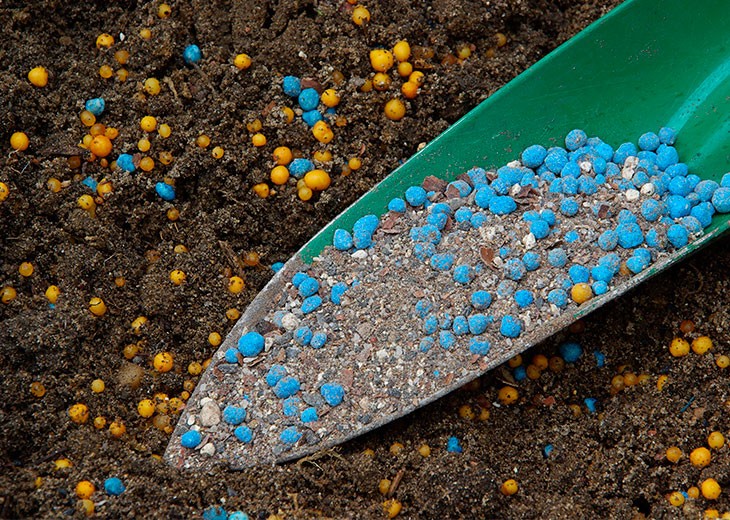
The third feeding is carried out in the bud formation phase
At this point, it is very important to provide plants with a sufficient amount of phosphorus and potassium, which play a decisive role in the formation of future flowers. If there is a lack of these elements, abundant flowering can not be expected
At the end of August, they begin to prepare tubers for wintering. Top dressing at this time is carried out with nitroammophos and superphosphate.
Shaping and garter
During the summer, dahlias form stepchildren in the leaf axils. So that they do not weaken the main shoot, it is recommended to periodically remove them. If this is not done, then the flower, to the detriment of flowering, forms too much leaf mass. Small-flowered varieties of dahlias should not be pinned: pompom, collar, anemone, etc.
After four leaves are formed on the central shoots, they must be pinched. As a result of this, lateral shoots begin to grow, which are pinched over the second pair of leaves. This method allows the plants to form lush bushes. You should be aware that more than three central shoots should not be left on one plant.

To get large flowers, you need to pluck out almost all the side buds. If this is not done, then there will be more colors, but they will be smaller. The first buds should also be plucked out, if they are left, then the further development of the bush begins to be delayed.
Tall varieties need a garter of peduncles. Their fragile stems are not able to withstand the wind and therefore break easily. To do this, a colo is driven in next to each bush, the height of which should correspond to the height of the peduncles.For the garter, it is advisable to use a soft material that will not cut into the stems.
Dividing tubers
The most common and easiest way to produce well-developed flowering plants in the first year of growing. The division of the tubers is carried out after the sprouts have hatched on them. To do this, large specimens are carefully separated by hand or with a sharp knife according to the number of sprouts. After that, the places of the cuts must be sprinkled with charcoal powder and dried a little.

Cuttings
This method is less common, it is mainly used only by experienced florists, since it requires certain skills. To propagate dahlias by cuttings, you need to get the tubers out of storage at the end of January and plant them for germination. After the sprouts reach a height of 9-10 cm, you can start grafting. To do this, they are cut off, and then planted in any loose substrate. The optimum rooting temperature is + 22 ° C.
If everything was done correctly, the first roots will appear on the cuttings in 2-3 weeks. After they are completely rooted, they are seated in separate containers. Young plants are planted in open ground in early May, they need to be looked after in the same way as for specimens obtained as a result of dividing tubers.

Problems after planting or transplanting
Dahlias can wither, poorly or not bloom at all for several reasons:
- They planted it in the shade, the stems are stretched out, the bushes do not have enough strength to bloom.
- The roots are flooded with excessive watering or rain, rot, and behind them the bush dies.
- It's hot, there is no watering, the bushes are drying out.
- Extra stepsons and stems were not removed, thickets of tops grew, which absorbs a lot of nutrition from the ground, there is no longer enough strength or time for flowering.
- The bushes were overfed with nitrogen fertilizers, there is food for the stems and leaves, but not for flowering.
- Diseases and pests attacked, pumped out juices, plants do not heal.
- There were not enough warm days: the variety is late, but delayed with germination and planting.
These problems will not occur if you follow the rules of planting and care already outlined above. As for the lack of flowering, they usually wait for it until the end of summer - autumn, when it is too late to do anything. Reveal your mistakes and do not commit them in the future, then you will be able to grow real beauty.
Dahlias are demanding already at the planting stage. But this makes them even dearer and dearer to the heart. If everything is done correctly, then the bushes will bloom for a long time and beautifully to the envy of all neighbors and to your delight.
Dahlia, how to propagate dahlias, planting and care
Yesterday - the sun was already glowing low -
Among the dahlias I walked yours,
And like a living odalisque
Each of them stood.
A. Fet
The beginning of the book
Dahlias fall flowers
Dahlias are beautiful fall flowers. September
This beautiful flower, dahlia, belongs to the Asteraceae family. In total, there are 12-15 species of dahlias in nature. Cultural forms of dahlia are represented by a huge (more than 12 thousand) number of varieties.
Dahlia is a herbaceous perennial with root tubers. Storage roots (tubers) live 3-4 years, thin suction roots are formed on them annually. New adventitious storage roots develop at the base of the shoots of the current year.
Usually tubers are located under groups of renewal buds. A kind of complexes are formed (kidney + root).
How to breed dahlias
Dahlia reproduces vegetatively, except for non-double varieties
The main methods of vegetative propagation of dahlias are dividing the root tuber and cuttings. Young
Dahlia tubers are planted in boxes and sprinkled with light sandy soil. At the same time, they make sure that the root collar is open, and the earth is moistened. After 7-10 days, when the eyes reach a size of 1-1.5 cm, division can be carried out. Depending on the size and number of awakened eyes, the root tuber is cut into 3-6 parts.Each separated part should have a piece of the root collar and at least one eyelet. Delenki are planted in boxes or pots so as not to fill up the incision site of the root collar. Dividing root tubers rejuvenates them.
The most effective and common way to propagate a dahlia is by cuttings.
How to water dahlias.
Planting (disembarking) dahlias
Dahlias are planted in early June, when the danger of frost has passed.
Plants are planted 3-4 cm deeper than it grew before, covering the first internode with earth. After landing
Dahlia care, pinching, bush formation
Pinching dahlias (pinching) buds. J. Ippolitova
Continuation of the book "The Language of Flowers"
Return - to the table of contents - Literature
.
- Dahlia planting in the ground
- Dahlias new varieties
- Dahlia storage
- Dahlias planting and care photos
- Dahlias preparing for planting
- Dahlia planting preparation
- Dahlias planting and care in the open field
- Propagation of dahlias by cuttings
- Dahlias perennial planting
- Dahlias propagation by cuttings
- Dahlias care for them
- Dahlia breeding
- Dahlia perennial planting and care
- How to prepare dahlias for planting
- How to store dahlias correctly
- Dahlia planting dates



